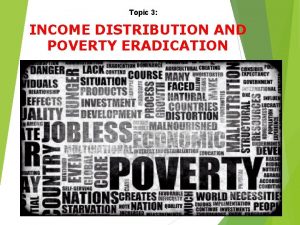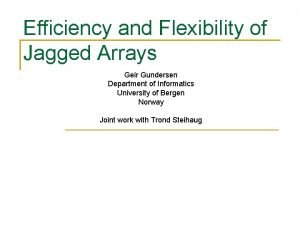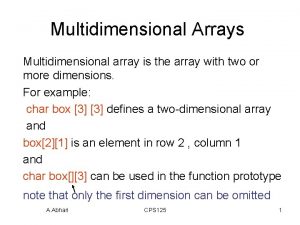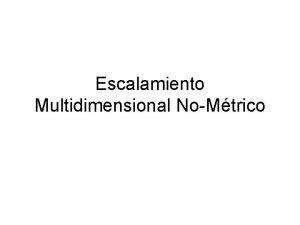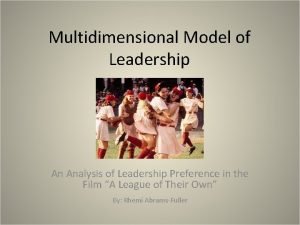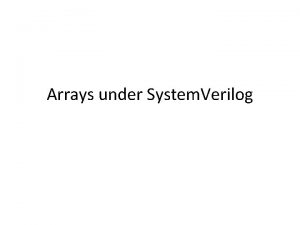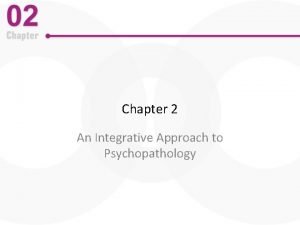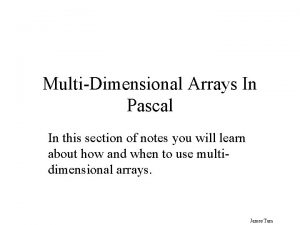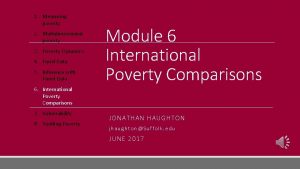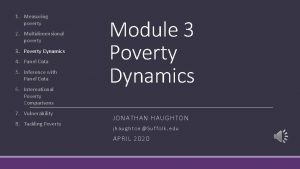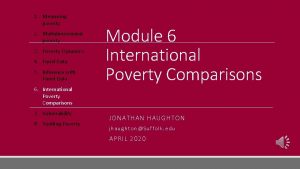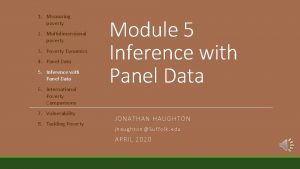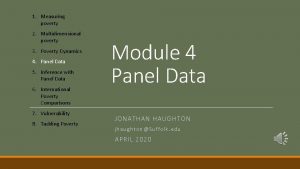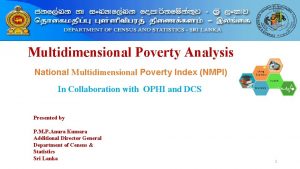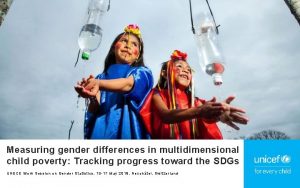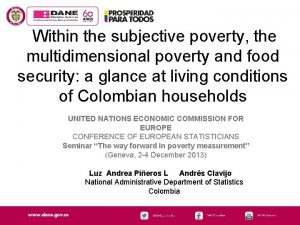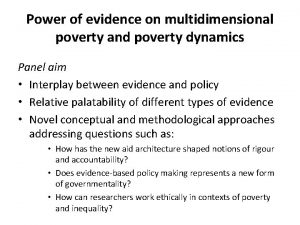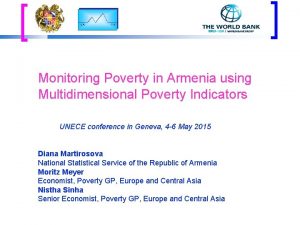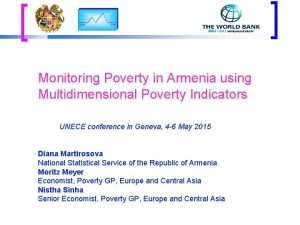1 Measuring poverty 2 Multidimensional poverty 3 Poverty














- Slides: 14

1. Measuring poverty 2. Multidimensional poverty 3. Poverty Dynamics 4. Panel Data 5. Inference with Panel Data 6. International Poverty Comparisons Module 7 Vulnerability to Poverty 7. Vulnerability to Poverty JONATHAN HAUGHTON 8. Tackling Poverty jhaughton@Suffolk. edu APRIL 2020

Objectives 1. Explain why measures of current poverty are inadequate 2. Define vulnerability to poverty. 3. Explain how to measure vulnerability to poverty (vht), given measures of expected consumption (E(ct+1)), its variance (σ2), the poverty line (z), and a normality assumption. 4. Outline the steps required to measure vulnerability to poverty, given data from a cross-sectional household survey. 5. Critically analyze the methodological issues related to the practical measurement of vulnerability to poverty 6. Itemize the main sources of risk faced by households. 7. Describe the nature, purpose, and principal contents of Risk and Vulnerability Assessments. April 2020 JH: POVERTY MEASUREMENT COURSE 2

Why measure vulnerability? Poverty measures the poor ex post Policy needs to target the future poor; being poor now may be a poor guide to the future A household is vulnerable to poverty if it is likely to be poor in the future (ex ante poverty) April 2020 JH: POVERTY MEASUREMENT COURSE 3

Vulnerability to Poverty Defined “The propensity to suffer a significant welfare shock, bringing the household below a socially-defined minimum level” ◦ What shock? ◦ To consumption/capita? Or (unsmoothed) income/capita? ◦ What minimum? ◦ Poverty line? ◦ How measure propensity? ◦ In next year? ◦ Within next few years? April 2020 JH: POVERTY MEASUREMENT COURSE 4

Levels of vulnerability If probability of being poor in future is: ◦ 50%+: highly vulnerable ◦ Greater than average poverty rate: vulnerable ◦ Less than average poverty rate: not vulnerable ◦ But you still might be unlucky April 2020 JH: POVERTY MEASUREMENT COURSE 5

The challenge Vulnerability is a probability, potentially based on huge amounts of information, such as ◦ Household assets, education, skills ◦ Risks faced – drought, food prices, illness, etc. ◦ Ability to handle risk – e. g. by dissaving, borrowing, working harder Simplify: ◦ Expected consumption/capita next period: ◦ Variance of expect consumption/capita: ◦ Poverty line: z ◦ Assume is normally distributed. April 2020 JH: POVERTY MEASUREMENT COURSE 6

Basic calculation Example 1: Expect consumption/capita of 55, standard deviation of 13, poverty line of 40. ◦ Probability of poverty is 12. 4%, = vulnerability ◦ norm. dist(40, 55, 13, 1) Example 2: As 1, but = 47. 5, sd = 6. 5. ◦ Probability of poverty is 12. 4% = vulnerability! April 2020 JH: POVERTY MEASUREMENT COURSE 7

Measuring E(C) and σ Chaudhuri et al. (2002) 1. Estimate econometrically: ◦ X variables include household characteristics ◦ Use this to predict c, assuming X doesn’t change ◦ Note assumption: 2. Regress squared residuals from 1 on same X variables to estimate and hence the estimated variance of E(c) for each household. 3. Use to measure vulnerability for each household: April 2020 JH: POVERTY MEASUREMENT COURSE 8

Results: Indonesia Poverty rate was 22%; 45% vulnerable ◦ Consistent with reported fears of poverty ◦ Makes targeting harder ◦ More than half the vulnerable population not poor now ◦ And some poor are not vulnerable! April 2020 JH: POVERTY MEASUREMENT COURSE 9

Issues Measurement error ◦ Noise likely inflates σ; Pritchett et al. (2000) reduce it by 30%. Babies ◦ Kamanou & Morduch (2002) claim a quarter of σ is due to demographic changes; how interpret? Measurement of σ ◦ Cross-section is not ideal; but longitudinal data are very rare Normal distribution ◦ We assume ln(C) ~ N(E(C), σ²); use empirical distribution? April 2020 JH: POVERTY MEASUREMENT COURSE 10

Sources of Vulnerability Difficult to model in practice April 2020 JH: POVERTY MEASUREMENT COURSE 11

Risk and Vulnerability Assessments “Diagnostic tools” favored by World Bank ◦ Understand sources of vulnerability to poverty: ◦ What are the main and most severe shocks? ◦ Which groups are most at risk from these? ◦ Catalog public interventions related to social risks ◦ Identify the “policy gap” Ask how vulnerable households can ◦ Reduce risk (e. g. migrate; build dikes) ◦ Mitigate risk (e. g. build up savings; diversify income) ◦ Cope with shocks (e. g. sell assets, borrowing) April 2020 JH: POVERTY MEASUREMENT COURSE 12

Some lessons Vulnerability to poverty: ◦ Is measurable, albeit not easily ◦ No consensus yet on how best to do this ◦ Is more widespread than poverty ◦ Shifts the focus to social protection ◦ … which also includes protecting children, etc. April 2020 JH: POVERTY MEASUREMENT COURSE 13

Notes on the Reading Haughton & Khandker, chapter 12 Dercon has a good overview ◦ Dercon, Stefan. 2001. Assessing Vulnerability to Poverty. Paper prepared for the U. K. Department for International Development. Department of Economics, Oxford University. For a recent summary of the state of the art: ◦ Naudé, W. , Santos-Paulino, A. , and Mc. Gillivray, M. (2009). Measuring Vulnerability : An Overview and Introduction. Oxford Development Studies, 37(3): 183 -191. Chaudhuri et al. set out a practical methodology ◦ Chaudhuri, Shubham, Jyotsna Jalan, and Asep Suryahadi. 2002. Assessing Household Vulnerability to Poverty from Crosssectional Data: a Methodology and Estimates for Indonesia. Discussion Paper Series No. 0102 -52, Department of Economics, Columbia University, New York. April 2020 JH: POVERTY MEASUREMENT COURSE 14
 Distinguish between absolute and relative poverty
Distinguish between absolute and relative poverty Multidimensional turing machine
Multidimensional turing machine Jagged array vs multidimensional array
Jagged array vs multidimensional array Multidimensional reporting
Multidimensional reporting Multidimensional scaling - ppt
Multidimensional scaling - ppt Multidimensional array
Multidimensional array Multidimensional or hypervolume niche
Multidimensional or hypervolume niche Distance matrix example
Distance matrix example Escalamiento multidimensional no métrico
Escalamiento multidimensional no métrico Multidimensional model of leadership
Multidimensional model of leadership Processing multidimensional array
Processing multidimensional array Systemverilog multidimensional array initialization
Systemverilog multidimensional array initialization Integrative approach to psychopathology
Integrative approach to psychopathology One-dimensional vs multidimensional models
One-dimensional vs multidimensional models Pascal 2d array
Pascal 2d array
